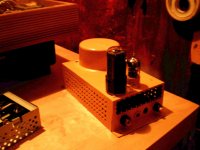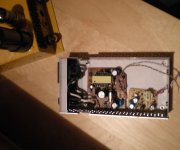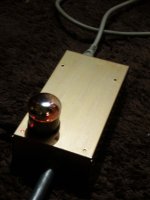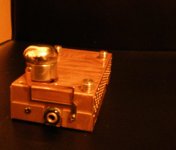Yep I got that, and I'm familar with good guitar and keyboard amps. I'd really like to see the comparison. The Toa is a general purpose commercial amp not really designed for a guitar amp per se, but I'd love to hear the comparison. DIY on a shoestring vs an inexpensive good quality redily avalable amp. I've used them for small keyboard and guitar setups in a pinch and have been plesently suprised. Just basic treb. bass controls no effects....
Distortion?
When you are all done compare it to a 10-30 watt Toa amp from ebay like the BG series. You can pick em up for well under $75. No tubes in there but I'd be surprised if it doesn't beat the home built units described here. I know I strayed off the topic a little.....sorry
TOA amps are great for bass and for keyboard, but horrible for lead guitar. However, you can use it with a pedal that simulates tube amp overdrive, but it is a different story. Like fast food versus home made dinner.
Yep I got that, and I'm familar with good guitar and keyboard amps. I'd really like to see the comparison. The Toa is a general purpose commercial amp not really designed for a guitar amp per se, but I'd love to hear the comparison. DIY on a shoestring vs an inexpensive good quality redily avalable amp. I've used them for small keyboard and guitar setups in a pinch and have been plesently suprised. Just basic treb. bass controls no effects....
Why do comparison for amps that were designed for completely different purposes? And what's the challenge of just writing a check, this is a DIY forum after all...
Jaz
When you are all done compare it to a 10-30 watt Toa amp from ebay like the BG series. You can pick em up for well under $75. No tubes in there but I'd be surprised if it doesn't beat the home built units described here.
Oh no another challenge.....no I'm not taking the bait this time......no not me.....nnnnooooooo.
We all wound up here because someone told us we couldn't make little tube amps with less than $100 worth of parts. Well several amps were made. Now you can buy a genuine Chinese made tube guitar amp for about $100. Some even have popular brand names stuck on their faces. Does that mean anything anymore, you can go down to the car dealership and buy a new car with a Fender branded stereo stuck in the dash......Well you used to be able to buy a new car that had a Bose stereo in the dash! Fender = Bose????
I purchased several dead guitar amps at a hamfest for $5 each. The Fenders and the Crate will be gutted and used for their cabinets. Why? Because $5 is a good price for an empty box with a shiney Tolex wrapper! The Crate even has a real reverb tank and a decent speaker.
How does one determine whether the TOA amp "beats" the home built amp? It might win in the sheer loudness department, but the only TOA amp I ever had was one I got from a dumpster, fixed, played for about 5 minutes, then gave away. Didn't cut it as a guitar amp, but it wasn't intended for that use.
Fetch a $75 Ebay TOA and set it next to my 5 tube $100 home build, plug in a Strat, set all controls on 10 (or 11 if so equipped) and rattle off your best Jimi impersonation. TOA....I don't think so.......no I didn't say that.....no not again.....
Oh, I am working on a little low cost tube amp to put inside the guitar......find me one of those on Ebay.....Oh I guess there is some use for DIY after all.......we build them because we can.....not because we should....
An old rocker once said that "You can't always get what you want" but if you try some time you can MAKE it!
Not knowing what a TOA amp looks like I can't talk much about their suitability for guitar. Now as far as SS, I will be making a 10-20W amp for the heck of it (no challenge, still have some ideas from the last one to get through) but have not decided on all SS or to use a tube preamp. I would like to do an all pentode preamp running low voltages but for now it is just an idea. As soon as I get the amp I am working on done I am getting back to my 5E3-BF amp (again no challenge here).
Not knowing what a TOA amp looks like I can't talk much about their suitability for guitar.
The one that I had was a simple box with 2 mike inputs and a line in. Mikes were XLR and phono, switch selectable. 3 volume knobs, 1 bass, 1 treble. I think these were designed for building paging and background music, not live sound situations.
It sounded like 30 to 40 watts through a single 12 inch guitar speaker. A guitar would just provoke distortion at full crank. I fed it with a Zoom DSP stomp box and it didn't impress. It went bye bye.
Both of the amps I designed for this challenge are still alive and screaming. Neither ever received a proper cabinet.
AMP2.4 now has a mosfet PI and copying a page from your playbook, a switch. One position puts a capacitor from the grid of one output tube to ground. The other position puts a cathode bypass capacitor to ground for the output tubes. With the switch in the first position the amp sounds the way it always did. It is the same except for a mosfet follower driving one output tube grid of a self split output stage. The cathode resistor is too small for a good split, so it is mostly SE. In the other position the output stage is fully P-P and makes about 6 watts. It really screams.
Amp 3.2 is untouched and still cranks. It makes 17 watts at 5% distortion and over 20 when all controls are set on 10. I put a cheap 25 watt "L-pad" on the output so the amp can run flat out, but the speaker volume can be toned down. Total parts cost under $100.........maybe not counting the knobs
In this economy Tubelab sales have been near zero, so to cut expenses Sherri and I cleaned out our warehouse, and sold, trashed, or given away most of the stuff. My collection of 100,000 tubes is now under 10,000 and sadly about 1000 pounds of iron went to scrap. I still have stuff stashed in every room of this house, and more has to go. On the positive side a $2500 per year rent expense is gone. All of my free time for the last 6 months was devoted to this operation, and much of the rest of the year will be spent organizing the remaining mess.
I have a new camera that does HD video and a new computer, so as soon as I can clean off the workbench there will be video of both amps and a few new projects. I plan to do video builds of the Tubelab amps since they have been requested.
Hi again. I'm working today with electronic projects. You can see my challenge revived but this time I plan to use it as a guitar preamp. It has a 6N23P stage going to the 6V6. Different OT too. Sounds very good. Plan to compare it with another cheapo, a single pentode preamp. You can see it has two SMPS, one from a printer (30V) and one from a cell phone charger (6V). Too late to install the socket today, will finish it tomorrow. Probably.
Attachments
Hi again. I'm working today with electronic projects. You can see my challenge revived but this time I plan to use it as a guitar preamp. It has a 6N23P stage going to the 6V6. Different OT too. Sounds very good. Plan to compare it with another cheapo, a single pentode preamp. You can see it has two SMPS, one from a printer (30V) and one from a cell phone charger (6V). Too late to install the socket today, will finish it tomorrow. Probably.
30V b+?! Tell us more!
Jaz
Hi jazbo8. 30V because I don't have more, I'd like to have more but I don't. 
Nah to the sound of starved triodes so pentode it is. BTW, I've no idea how to design a pentode starved plate circuit. I've been looking to some regen circuits but... the only thing I know at this time of the day is that I intent to put a variable pot at the screen. More to come.
Nah to the sound of starved triodes so pentode it is. BTW, I've no idea how to design a pentode starved plate circuit. I've been looking to some regen circuits but... the only thing I know at this time of the day is that I intent to put a variable pot at the screen. More to come.
Hi jazbo8. 30V because I don't have more, I'd like to have more but I don't.
Nah to the sound of starved triodes so pentode it is. BTW, I've no idea how to design a pentode starved plate circuit. I've been looking to some regen circuits but... the only thing I know at this time of the day is that I intent to put a variable pot at the screen. More to come.
Found this on allaboutcircuits:
"When operating pentodes at low voltages you need to abandon some of the traditional design methods.
You will need a large anode resistor (traditional starved designs used anything up to 5Meg!).
You also need to be aware of grid current, which will bias the valve very cold if you have a conventional grid leak resistor. A neat way to get around this is to connect you grid leak to the 12V supply, rather than to ground/cathode! Playing with the value, you should be able to get some useful gain.
Also, play with the screen voltage, as the gm of pentodes varies wildly at low screen voltages there will usually be a 'sweet spot'."
Might be worth a try... I will this weekend if I have some free time.
Jaz
I would like to see (hear?) what you did. I am on another forum where a student wanted to analyze make a Marshall amp as a thesis for school but they only allow up to 40V. I suggested and tried a couple of 6AU6's at 40V and found they sounded much better than 12A*7 tubes in low voltage starved plate. Plan to get back to it soon.
Well, it works. And it's very quiet - no hum and no microphonic noises. I reckon gain is around 30. It's not enough to drive a two stage SE audio amp into heavy distortion. However, in front of my Champ this thing does Metal. I haven't played much but distortion is fuzzy, ear-piercing.... kinda fun but I wouldn't say tube-like. Warm, it is not. Anyway, early days, random values and no tweaking yet. Plate resistor is 100K, screen resistor is 1K and cathode resistor is 2.7K.
Jazbo8 - I read that but I think you'd run into problems with a high value plate resistor. The trick with pentodes is not to aim for too much gain, otherwise microphonics becomes a huge problem.
Printer - It doesn't sound like an 12AX7, that's for sure. But, as I said before, I've only played like 10 minutes. With the Champ volume knob on 2 I get very heavy overdrive. On 10, this thing is crazy, I'm not into metal anyway.
Oh, I left the heater supply floating and B+ goes directly to the plate resistor. No additional filtering. Very quiet. Hmmm.
Jazbo8 - I read that but I think you'd run into problems with a high value plate resistor. The trick with pentodes is not to aim for too much gain, otherwise microphonics becomes a huge problem.
Printer - It doesn't sound like an 12AX7, that's for sure. But, as I said before, I've only played like 10 minutes. With the Champ volume knob on 2 I get very heavy overdrive. On 10, this thing is crazy, I'm not into metal anyway.
Oh, I left the heater supply floating and B+ goes directly to the plate resistor. No additional filtering. Very quiet. Hmmm.
Attachments
Jazbo8 - I read that but I think you'd run into problems with a high value plate resistor. The trick with pentodes is not to aim for too much gain, otherwise microphonics becomes a huge problem.
Makes sense, with the high plate resistors, the pentode will have too much gain at low current = crazy distortion.
Jaz
the pentode will have too much gain at low current = crazy distortion.
It's not about crazy distortion, I like that. I like gain. The problem is that at high gain the pentode picks up all kinds of noises.
Well....I have been playing for two hours and I have to retract my comments of not sounding tube-like. I was feeling guilty for saying that. I bypassed the first stage of my Champ and played with this pentode preamp then back to the 6SL7. Just playing with a slight overdrive. Totally different tone, I can't decide which one I like best. I like both. I thought this was going to be some kind of a joke, a pastime, an experiment; but it sounds much better than it should.
I have a lot of stuff to do so this is my last comment about this preamp. Won't tweak the circuit, not anytime soon anyway. Pretty busy for the next couple of months.
My favourite pentode 6AK5 is not at all hungry for volts.
Picked up a Peavey Royal 8 at the 2nd hand shop nice and cheap. Had to "improve" it of course. One input jack is the standard input, and the other feeds a triode strapped 6AK5 (gain of 20) in front of the 12AX7. I took the bypass cap off the 2nd triode to manage the gain structure.
No more playing for now. Moving house from Australia to New Zealand.
Picked up a Peavey Royal 8 at the 2nd hand shop nice and cheap. Had to "improve" it of course. One input jack is the standard input, and the other feeds a triode strapped 6AK5 (gain of 20) in front of the 12AX7. I took the bypass cap off the 2nd triode to manage the gain structure.
No more playing for now. Moving house from Australia to New Zealand.
So I am trying an alternative board material, got some eyelets from a craft store and put them in some kitchen top laminate. Seems like it will work.
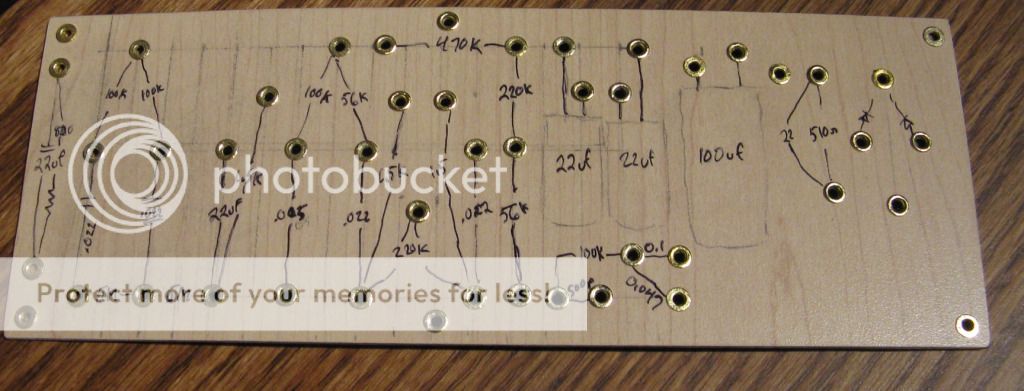
It does work, I have done that at least 15 times.
If you check around with the local cabinet shops they often carry what we call color core laminate. It is a tiny bit thicker and comes in plain/solid colors.
It is not as hard to drill.
I got a bunch free, scrapes, and leftovers they were about to throw out.
ColorCore - Formica Group
It does work, I have done that at least 15 times.
If you check around with the local cabinet shops they often carry what we call color core laminate. It is a tiny bit thicker and comes in plain/solid colors.
It is not as hard to drill.
I got a bunch free, scrapes, and leftovers they were about to throw out.
ColorCore - Formica Group
Cool. I originally glued two pieces together and it was really stiff but my eyelets were a little short to go through them both. With the six mounting bolts I don't think I will have a problem but it is good to know there is some thicker material. Can't beat free either, I was going to ask our carpentry department if they had some scraps and before I got to their shop I saw a bunch in their garbage can. I found it drilled easy enough but you just had to take care the bit does not walk away from the intended spot. (Lack of focus on the bit's part)
I put some eyelets in the mounting bolt holes, not sure if it is necessary but I did not want to accidental crack the board. This seems to be a easy and quick way to get a circuit built up. I like it.
It's finished and I'm very happy with it. Thick, meaty distortion. It's called 24K for reasons I don't need to explain. I don't like jewelry looks but I lit up a joint and this was the unfortunate result. Haha. No worries, just for fun.
* Yes, photo no good. Never proud of the stuff I build so why bother.
* Yes, photo no good. Never proud of the stuff I build so why bother.
Attachments
"The amplifier must be reasonably safe. No line-powered (non-isolated) designs will be considered"... Why, if it's a safe line-powered design and the chassis is intended un-exposed?
Before even considering the serious safety issues surrounding non-isolated circuits, these designs are illegal in many parts of the world.
Why place your great-grandson at risk of electrocution, to save the minimal expense of an isolation transformer?
- Home
- Live Sound
- Instruments and Amps
- The Hundred-Buck Amp Challenge
